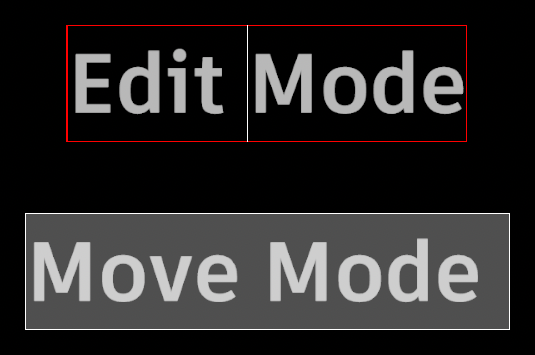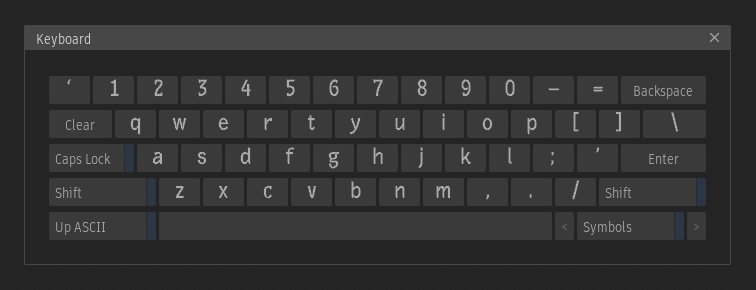Adding and Editing Text
Editing a Layer
A layer can be in Move or Edit mode. The mode is indicated by the layer boundary's colour.

- Move: The layer boundary is white. You can grab it to move it to a different position. Fewer options are available from the context menu.
- Edit: The layer boundary is red. You can add, select, or remove characters. Additional options are available from the context menu.
A layer is automatically set to Edit mode when it is added. To enter Edit mode for an existing layer, double-click on it either within the Layers list or directly in the viewport, or select Edit from the layer's context menu in the viewport. Once a layer is in Edit mode, other layers selected using a single click are also in Edit mode.
To exit Edit mode, either:
- Press the Esc key to keep the layer selected, but in Move mode.
- Click outside of the layer inside the viewport. No layer is selected.
Entering Text
The text you type may be as short as one letter or word or as long as several paragraphs. If the text is long or exists in a word processor, you can load the text file into the current layer.
You enter and edit characters much like in a word processor. You type characters using the keyboard and many known text editing keyboard shortcuts. When a new layer is created, the layer is in Edit mode, allowing text to be entered. To modify the text of an existing layer, double click the layer to enter Edit mode. Once in Edit mode, click once to insert the cursor between two characters, double-click to select the whole word, triple-click to select the entire line, and quadruple-click to select all characters on the layer. You can also paste the current text selection (from a shell/terminal or any other application) by pressing the middle mouse button or by using the pen button.
Using the On-Screen Keyboard
Click On-Screen Keyboard to open the application's Keyboard window and type characters using buttons. Alternatively, the OS on-screen keyboard can also be used. The on-screen keyboard makes it easier to type special characters and glyphs that are not available on a physical keyboard. To close the application Keyboard window, click the X at the top-right of the window or click On-Screen Keyboard again.

To display extended characters contained in the selected font, enable Up ASCII or Symbols. Use the arrow buttons beneath the Symbols button to navigate through pages.
Using ASCII codes
Characters can be added using their respective ASCII codes (decimal numeral system). For example, to add the "%" character:
- Double-click a layer to enter Edit mode.
- Place the cursor where you want to add a character.
- Hold the Alt key on your physical keyboard.
- Enter the decimal numeral code of the character using the physical keyboard's keypad. The code for "%" is 37.
- Press the Enter key on the keypad.
Overwriting Text
By default, new characters are inserted in a layer, after the cursor. To overwrite existing characters while preserving their attributes and axis transformations, select the Overwrite mode using the drop-down located in the viewing area's toolbar.

| Select: | To: |
|---|---|
| Insert | Insert new characters in a layer, after the cursor. The values set in the Attributes menu and Characters Axis are used. |
| Overwrite | Overwrite existing characters while preserving the values set in the Attributes menu and Characters Axis. Use this option to replace characters in a setup or preset. |
Loading a Logo
You can add a logo to text layers and rolls to credit sponsors, contributors, and products. A logo is added in a paragraph and its attributes can be modified.
Inserting a Logo in a Paragraph
To insert a logo in a paragraph:
- Click Load Logo in the Font section. This operation makes the main Workspace appear.
- Select a front clip, and optionally, a matte clip for the logo. The logo is inserted at the cursor position in the text layer.
Modifying the Attributes of a Logo
Some parameters from the Attributes submenu can be applied to a logo:
- Size
- Opacity
- Kerning
- Underline
All Characters attributes from the Axis submenu can also be applied.
Selecting Characters
All characters are selected when you select a layer so changes made to character-based attributes are applied to all of them. To apply changes to some characters only, enter Edit mode for the layer and use one of the following methods to select characters:
- Click on a character and drag the cursor to expand the selection.
- Use the selection options from the Layers list's Select drop-down or from the layer's context menu.
- Use keyboard shortcuts.
Selection Keyboard Shortcuts
| Keyboard Shortcuts | Keystrokes |
|---|---|
| Select all Characters in a Paragraph | Ctrl + Alt + P |
| Select One Character Left | Shift + Left Arrow |
| Select One Character Right | Shift + Right Arrow |
| Select One Line Up | Shift + Up Arrow |
| Select One Line Down | Shift + Down Arrow |
| Expand Selection to Beginning of Line | Shift + Home |
| Expand Selection to End of Line | Shift + End |
| Expand Selection to Beginning of Roll | Shift + Ctrl + Page Up |
| Expand Selection to Previous Page of Roll | Shift + Page Up |
| Expand Selection to Next Page of Roll | Shift + Page Down |
| Expand Selection to Beginning of Roll | Shift + Ctrl + Page Down |
Use the common Select All keyboard shortcut to select all layers while in Move mode and all characters while in Edit mode. To deselect all selected layers or characters, use the Deselect keyboard shortcut.
